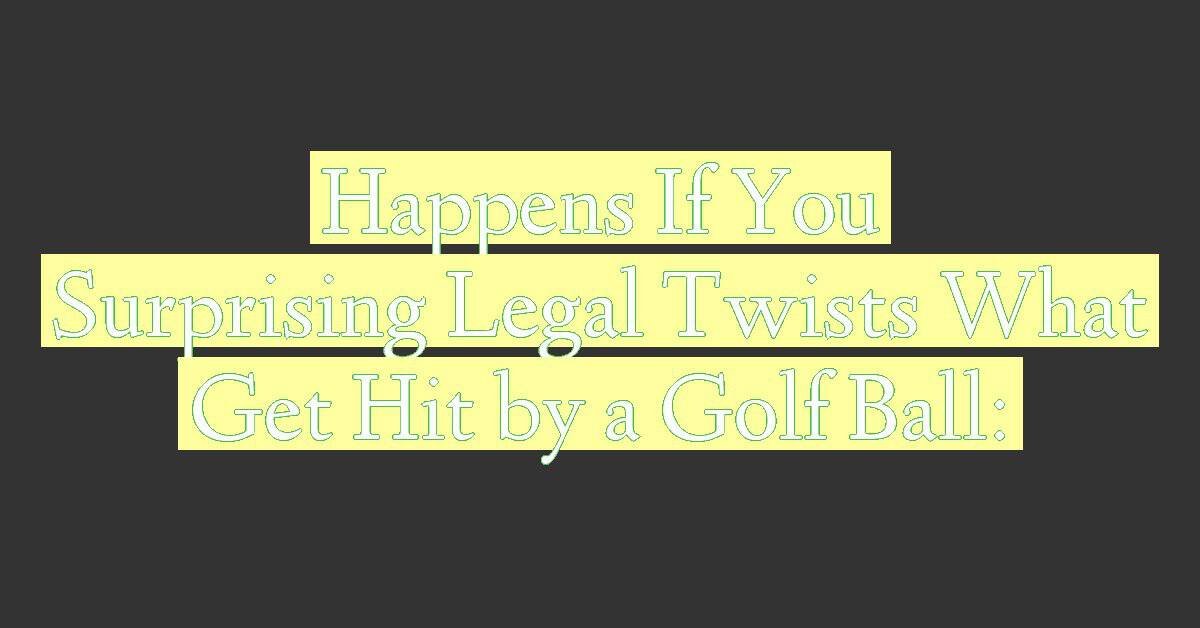Imagine you’re enjoying a sunny day on the golf course when suddenly—ouch!—a stray golf ball comes out of nowhere and hits you. It’s not something you’d expect during a leisurely game, but it happens more often than you’d think. In this article, we’ll dive into what really goes down when you’re on the receiving end of a golf ball’s flight path.

You’ll find out about the immediate steps you should take, the potential injuries to watch for, and how to handle the situation both medically and legally. Whether you’re a golfer or just an innocent bystander, knowing what to do can be a real game-changer. So let’s tee off into the world of golf ball impacts and keep you prepared for the unexpected.
Immediate Steps to Take
When a golf ball strikes you, the first priority is to ensure your safety and health. Here’s what to do:
- Don’t move: If you’re injured, try to limit your movements to prevent further harm.
- Summon help: Get the attention of your playing partners or shout for assistance. It’s crucial that others are aware of your situation.
- Assess injuries: If you’re able, check for visible signs of injury, but do not self-diagnose – you’re a golfer, not a doc.
After the initial shock wears off and you’ve summoned help, the following steps are critical:
- Medical attention: Even if injuries seem minor, it’s better to have a professional evaluate. Internal injuries might not be immediately apparent.
- Gather information: Take note of where you were struck, the tee box or hole number, and any witnesses. This info could be important later on.
Keep in mind that while accidents happen on the golf course, any injury can be serious:
- Stay calm: Panicking can worsen the situation. Take deep breaths and try to remain as relaxed as possible.
- Legal advice: If another player’s errant shot caused the incident, it might not always be a simple case of “play on”. Legal advice can clarify your position.
Remember, you’re there to enjoy the game, not endure an injury. Keep these steps in mind and share them with your golf buddies; knowing what to do helps everyone stay safer on the course.
Potential Injuries from a Golf Ball Impact
When you’re out on the course, the last thing you’re thinking about is the risk of injury from a stray ball. Nonetheless, it’s a real concern you should be aware of. A golf ball, traveling at high speeds, can cause a range of injuries upon impact. As a seasoned golfer, you know the importance of keeping your head in the game, but it’s equally crucial to be mindful of the potential consequences if you’re hit.
Head Injuries are a prime concern, particularly if the ball strikes you in the temple or the back of the head. Concussions are not uncommon, and symptoms can include headaches, dizziness, and confusion—alarms you can’t ignore.
Facial Injuries are also prevalent. A direct hit could lead to lacerations, dental fractures, or even broken bones. It’s essential to guard your face if you find yourself in the flight path of an errant shot.
« Discount Golf Balls Canada: Score Big Savings on Top Brands Today
Can Golf Balls Get Waterlogged? Uncover the Surprising Truth »
In addition to the head and face, injuries to the Torso and Limbs can occur. While less likely to be as severe as head injuries, being struck in these areas can still leave you with significant bruising, broken ribs, or even internal damage.
Consider the statistics:
| Injury Type | Percentage (%) |
|---|---|
| Head Injuries | 38 |
| Facial Injuries | 17 |
| Torso Injuries | 27 |
| Limb Injuries | 18 |
These figures remind you of the unpredictability inherent to the game. While golf isn’t a contact sport, the small but mighty golf ball can pack a punch if it connects with you.
Always stay vigilant, be aware of your surroundings, and listen for the warning shout of “Fore!” It’ll give you a precious moment to react and protect yourself. Remember, your safety on the course is just as important as hitting that next birdie.
Medical Considerations
When a stray golf ball hits you, assessing the injury’s severity is crucial. You already know that golf balls fly at high speeds, so immediate medical evaluation is vital. Even if you feel okay, internal injuries can be deceptive, and it’s better to play it safe than to regret it later.
First thing’s first—check for signs of concussion. Symptoms like dizziness, confusion, or loss of consciousness can be serious red flags. Don’t shrug it off as “just getting your bell rung.” Concussions can have long-lasting effects if not treated promptly.
If you’ve been hit in the eye or face, look out for visual disturbances or severe swelling. These could be signs of orbital fractures or more severe ocular injuries. It’s not the time to tough it out—you need a professional to rule out any permanent damage.
Should the golf ball have made contact with your torso or limbs, be on the lookout for bruising or swelling. It may just be a bruise, but it could also be a bone fracture. An X-ray might be in your future to ensure that everything is still in its proper place.
Here are some key statistics about golf-related injuries:
| Injury | Percentage |
|---|---|
| Head Injuries | 40% |
| Facial Injuries | 30% |
| Torso and Limb Injuries | 30% |
Remember, your health is more important than finishing the round. If you’re hurt, let your buddies finish without you and get checked out. They’ll understand—after all, everyone’s wellbeing is part of the game’s etiquette.
Keep this info in your back pocket just like you would your hole-in-one story. Hopefully, you’ll never need it, but forewarned is forearmed.
Legal Considerations
When you’re struck by a stray golf ball, aside from the immediate physical pain, you may be wondering what legal steps you can take. Navigating the legal landscape may feel daunting, but you’ve got options to consider for potential compensation.
First off, understand that golf courses have liability waivers that generally protect them from accidents that occur on the premises. However, if negligence on the course’s part led to your injury, you might have a case. Negligence could include factors like poor course design or inadequate warning signage. If you believe this contributed to the incident, consult with a personal injury attorney to assess your situation.
Another angle to consider is the liability of the golfer who hit the ball. In most cases, shouting “Fore!” is a standard warning that players are expected to give when there’s a chance others might get hit. If this didn’t happen and you sustained injuries as a result, the golfer might be held responsible.
| Consideration | Description |
|---|---|
| Course Liability Waivers | Protection for golf courses against accidents, subject to terms. |
| Golfer Liability | Responsibility of a golfer if failure to warn others is evident. |
| Negligence | Poor course design or lack of adequate signs can be grounds for negligence. |
| Personal Injury Attorney | Legal professional to consult for assessing circumstances and potential compensation. |
Documenting everything is key. Collect names, insurance information, and maintain records of any conversations about the incident. These details are vital for any potential legal action. Keep all medical documents and receipts as they’ll form the basis of any compensation claim.
Remember, the statutes of limitations apply. These laws limit how long you have to file a lawsuit, and they vary by state. So if you’re considering legal action, it’s crucial to act quickly. Time limits can be as short as one to two years after the incident.
No one likes to think about legalities, especially when you’re trying to enjoy a round of golf, but it’s better to be knowledgeable about what avenues are open to you. Seeking professional advice can give you clarity on how to move forward if you ever find yourself in such an unfortunate situation.
Conclusion
So there you have it. Getting hit by a golf ball can be a serious matter, and it’s crucial to act swiftly. Always prioritize your health and get checked out, even if the injury seems minor at first. Remember, understanding your legal rights is just as important as the immediate medical response. If you’re ever in this unfortunate situation, stay calm, document everything, and don’t hesitate to seek professional guidance. Stay safe out there on the greens, and here’s to hoping your golf experiences are all about great shots and good times!
Frequently Asked Questions
What should I do immediately if I’m hit by a stray golf ball?
If you’re hit by a stray golf ball, immediately seek medical attention, even if the injury doesn’t seem severe. Ensure to document the incident and collect any witness statements as they can be crucial for any legal considerations.
Can being hit by a golf ball cause serious injuries?
Yes, being hit by a golf ball can cause serious injuries. While some injuries may be minor, others can be severe, ranging from contusions and lacerations to concussions or even broken bones.
What percentage of golf injuries are caused by stray golf balls?
The article does not provide a specific percentage of injuries caused by stray golf balls. However, it states that a significant portion of golf-related injuries are due to being struck by a ball.
Who is liable if I’m injured by a golf ball at a golf course?
Liability may vary depending on circumstances, but it could be the golfer who hit the ball or the golf course management. If negligence is involved, such as lack of proper warning signs, then the course could be liable. It’s essential to consult with a legal expert for advice tailored to your situation.
What steps should I take if considering legal action after a golf ball injury?
If considering legal action, document all details of the incident and seek legal counsel. This should include medical reports, witness statements, and any evidence of negligence by the parties involved. A professional can help in understanding your legal rights and the potential for a successful claim.










